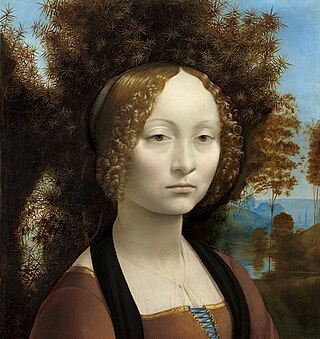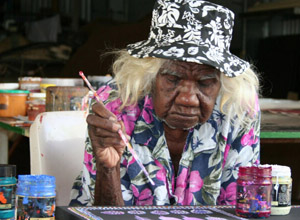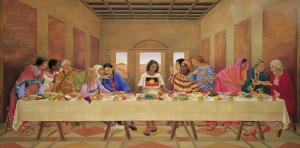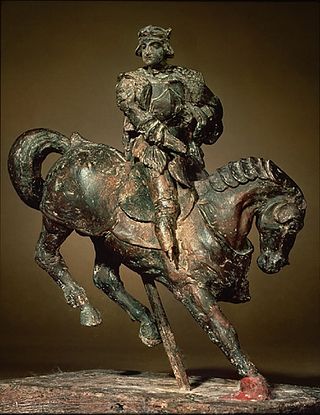Related Research Articles

Leonardo di ser Piero da Vinci was an Italian polymath of the High Renaissance who was active as a painter, draughtsman, engineer, scientist, theorist, sculptor, and architect. While his fame initially rested on his achievements as a painter, he has also become known for his notebooks, in which he made drawings and notes on a variety of subjects, including anatomy, astronomy, botany, cartography, painting, and paleontology. Leonardo is widely regarded to have been a genius who epitomized the Renaissance humanist ideal, and his collective works comprise a contribution to later generations of artists matched only by that of his younger contemporary Michelangelo.

Ginevra de' Benci is a portrait painting by Leonardo da Vinci of the 15th-century Florentine aristocrat Ginevra de' Benci. Exhibited at the National Gallery of Art in Washington, D.C. US; it is the only painting by Leonardo on public view in the Americas.
Lillian F. Schwartz is an American artist considered a pioneer of computer-mediated art and one of the first artists notable for basing almost her entire oeuvre on computational media. Many of her ground-breaking projects were done in the 1960s and 1970s, well before the desktop computer revolution made computer hardware and software widely available to artists.

The Virgin and Child with Saint Anne and Saint John the Baptist, sometimes called The Burlington House Cartoon, is a drawing by Leonardo da Vinci. The drawing is in charcoal and black and white chalk, on eight sheets of paper that are glued together. Because of its large size and format the drawing is presumed to be a cartoon for a painting. No painting by Leonardo exists that is based directly on this cartoon, although the drawing may have been in preparation for a now lost or unexecuted painting commissioned by Louis XII. The drawing is the only extant larger-scale drawing by the artist.

Nancy Graves was an American sculptor, painter, printmaker, and sometime-filmmaker known for her focus on natural phenomena like camels or maps of the Moon. Her works are included in many public collections, including those of the National Gallery of Art, the Brooklyn Museum of Art, the Smithsonian American Art Museum, the National Gallery of Australia (Canberra), the Des Moines Art Center, Walker Art Center (Minneapolis), and the Museum of Fine Arts. When Graves was just 29, she was given a solo exhibition at the Whitney Museum of American Art. At the time she was the youngest artist, and fifth woman to achieve this honor.

Leonardo da Vinci was an Italian Renaissance painter and polymath who achieved legendary fame and iconic status within his own lifetime. His renown primarily rests upon his brilliant achievements as a painter, the Mona Lisa and The Last Supper, being two of the most famous artworks ever created, but also upon his diverse skills as a scientist and inventor. He became so highly valued during his lifetime that the King of France bore him home like a trophy of war, supported him in his old age and, according to legend, cradled his head as he died.
Fiona Margaret Hall, AO is an Australian artistic photographer and sculptor. Hall represented Australia in the 56th International Art Exhibition at the Venice Biennale in 2015. She is known as "one of Australia's most consistently innovative contemporary artists." Many of her works explore the "intersection of environment, politics and exploitation".

Daisy Loongkoonan was an Australian Aboriginal artist and elder from the Nyikina people of the central western Kimberley region in Western Australia. Loongkoonan was born at Mount Anderson near the Fitzroy River. Her parents worked on cattle stations, and as she grew up, Loongkoonan followed them, mustering sheep and cooking in stock camps. Later she rode horses and mustered cattle.

The 16th-century portrait Mona Lisa, or La Gioconda, painted in oil on a poplar panel by Leonardo da Vinci, has been the subject of a considerable deal of speculation.

Richard Grayson is a British artist, writer and curator. His art practice encompasses installation, video, painting and performance. He investigates ways that narratives shape our understandings of the world. His art and curatorial practice focus on narrative and the visual arts, belief systems and material expression, and ways cultural practices allow translation between the subjective and social/political realms.

The First Supper (1988) is a work of art by Susan Dorothea White, based on Leonardo da Vinci's 1490s painting The Last Supper. White's painting is acrylic on a large wood panel and, in a challenge to the patriarchal concept of thirteen men on one side of a table, shows 13 women from all regions of the world; the woman in the position of Leonardo's Christ figure is an Australian aboriginal wearing a T-shirt with the Australian Aboriginal Flag. One woman seen is in the position of Judas. She dines on a Coca-Cola and a hamburger, while all the other women are seen with a bread roll and glass of water. The painting toured Australia in the Blake Prize for Religious Art exhibition in 1988, where it was ridiculed, before being exhibited in the artist's solo exhibition in Amsterdam, where it featured in the Dutch art journal Kunstbeeld: "The work shows clearly Susan White's thinking about human rights. It should be mentioned here that she sometimes places her many faceted talent at the service of the struggle for human rights".

Salvator Mundi is a painting attributed in whole or in part to the Italian High Renaissance artist Leonardo da Vinci, dated to c. 1499–1510. Long thought to be a copy of a lost original veiled with overpainting, it was rediscovered, restored, and included in a major exhibition of Leonardo's work at the National Gallery, London, in 2011–2012. Auction house Christie's stated just after selling the work in 2017 that most leading scholars consider it to be an original work by Leonardo, but this attribution has been disputed by other leading specialists, some of whom propose that he only contributed certain elements; and others who believe that the extensive damage prevents a definitive attribution.
Lila Katzen, born Lila Pell, was an American sculptor of fluid, large-scale metal abstractions.

Helidon Xhixha is a contemporary artist born in Durrës, Albania, in December 1970. Xhixha is known for his stainless steel sculptures, which is often fused with other mediums such as marble or brass.

Horse and Rider is a beeswax sculpture depicting a rider on a horse. The history of the sculpture is unknown before the 20th century. The work has been attributed to Leonardo da Vinci by the Italian art historian Carlo Pedretti, though most historians have ignored or denied the attribution. A number of casts have been made, using a mold taken from the wax original.

Shamsia Hassani is an Afghani street artist, a fine arts lecturer, and the associate professor of Drawing and Anatomy Drawing at the Kabul University. She has popularized "street art" in the streets of Kabul and has exhibited her art in several countries including India, Iran, Germany, United States of America, Switzerland, Vietnam, Norway, Denmark, Turkey, Italy, Canada, and in diplomatic missions in Kabul. Hassani paints graffiti in Kabul to bring awareness to the war years. In 2014, Hassani was named one of FP's top 100 global thinkers. She was recognized as one of the BBC's 100 women of 2021.
Miriam Stannage (1939–2016) was an Australian conceptual artist. She was known for her work in painting, printmaking and photography, and participated in many group and solo exhibitions, receiving several awards over her career. Her work was also featured in two Biennales and two major retrospective exhibitions.
Caitlin Cherry is an African-American painter, sculptor, and educator.
Mira Gojak is an Australian artist who was born in Adelaide in 1963 and now works in Melbourne. Her sculptures are like linear drawings in space, tracing the forces of gravity and suspension that we can feel. They create a sense of inside and outside space. Gojak is also known for her drawings. She has been awarded several times and has exhibited widely in Australia as well as Hong Kong.
References
- 1 2 http://www.printsandprintmaking.gov.au/catalogues/artist/7197/susan-dorothea-white.aspx?related=work National Gallery of Australia. Australian Prints, Drawings and Illustrated Books: WHITE, Susan Dorothea (Retrieved 12 December 2017).
- ↑ https://adb.anu.edu.au/biography/cant-james-montgomery-12291 Cant, James Montgomery (1911–1982) (Retrieved 1 May 2023)
- 1 2 White, Susan D. (2006). Draw Like da Vinci. London: Cassell Illustrated, p.144. ISBN 9781844034444.
- ↑ Young, E. 'Sculpture Feature of Exhibition'. The Advertiser, 28 October 1959.
- 1 2 3 May Harding: 'Successful art show by young B. Hill artist', The Barrier Miner, 28 Apr. 1962.
- ↑ http://www.john-beeman.com/henry_gibbons.html Henry Gibbons (Retrieved 13 December 2017)
- ↑ http://www.susandwhite.com.au/images/SDW_Solo_Broken_Hill_Apr_1962.pdf Exhibition of Paintings, Drawing and Prints by Susan White, 26 Apr. 1962 (Retrieved 1 May 2023)
- ↑ Thomas, D. The week in art, The Sunday Telegraph, 3 March 1963, p.30.
- 1 2 Wernig, Anton. "Central theme is the human being" (translation), Galerie Arndt (Munich), July 1980.
- 1 2 Margolis, Andrew. 'White, Kahukiwa, & Hotz in lively shows at Montserrat', Gallery & Studio (New York), Nov/Dec. 1998, p.13.
- 1 2 'Susan White - veelzijdig werk', Kunstbeeld (Amsterdam) October 1990, vol. 14 (10) p.62 (translation).
- ↑ Allen, Christopher. 'Ludicrous Leonardo', The Sydney Morning Herald, 23 December 1988, p.10.
- ↑ ' 'Jüngerinnen' beim Abendmahl', Der Weg (Cologne) March 1991, vol. 14, p.14 (translation).
- ↑ Juliane Brumberg, 'Abendmahl aus weiblicher Perspektive', Sonntagsblatt (Munich), 2 December 2001, p.22 (translation).
- ↑ Shugart, Helene Anna (1994). Disinheriting the father: The nature and function of feminist rhetorical appropriation (Thesis). ProQuest 304101235.
- ↑ Shugart, Helene A. (December 1999). "Postmodern irony as subversive rhetorical strategy". Western Journal of Communication. 63 (4): 433–455. doi:10.1080/10570319909374653.
- ↑ http://www.susandwhite.com.au/images/Sapere_Aude_Venice_55_Biennale_31_May_2013.pdf Sapere Aude, Circuito Off, 55. Biennale d'Arte di Venezia, May 2013 (Retrieved 2 May 2023)
- ↑ http://amarillo.com/stories/041202/fea_tooltime.shtml Heavens, Alan J. 'Tool time sublime: Exhibit turns tools into creative jewels', The Philadelphia Inquirer, 29 March 2002 (Retrieved 12 December 2017).
- ↑ https://www.dailytelegraph.com.au/newslocal/northern-district-times/harbour-sculpture-winners-announced-at-gala-opening-night-event/news-story/e2575f1727ea5feb7410203b6c7c634d Harbour Sculpture winners announced... (Retrieved 13 December 2017)
- ↑ http://www.susandwhite.com.au/images/2010_Fyre_SDW_Catalogue.pdf Cheryl Hannah (ed). Susan Dorothea White - Celebrating 50 Years of White's Art in a Unique Survey of Her Prints 1960-2010, Braidwood: Fyre Gallery, 2010 (see p.4)
- ↑ Smith, Selma (ed). The Printworld Directory, 11th ed, 2006, West Chester: Printworld, pp.1214–5.
- 1 2 "Drawing on Anatomy".
- ↑ http://www.drawingonanatomy.com.au/galleryD/2005sexvitruvian_DOA.html Drawing on Anatomy website (Retrieved 13 December 2017)
- ↑ Salazar-Sutil, Nicolás (June 2010). "Body Manifold: Mathematics (mis)performed by Vitruvian and Acephalic bodies" (PDF). Performance Research. 15 (2): 17–22. doi:10.1080/13528165.2010.490424. S2CID 11526674.
- ↑ https://archive.today/20071219162729/http://painting.about.com/od/productreviews/gr/DrawDaVinci.htm Boddy-Evans, Marion. Draw Like da Vinci by Susan Dorothea White, reviewed August 2006 (Retrieved 12 December 2017)
- ↑ Wood, Jacky. Mastering the essentials. Artists & Illustrators, June 2006, p.38.
- ↑ McCulloch, Alan, McCulloch, Susan & McCulloch Childs, Emily (eds). The New McCulloch's Encyclopedia of Australian Art, 2006, Melbourne: Aus Art Editions, p. 1020.
- ↑ "Nootambulla Gorge".
- ↑ "Woman Oppressed".
- ↑ "The Cup of Tea".
- ↑ "The Seven Deadly Isms".